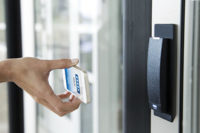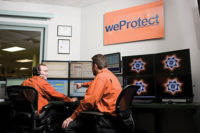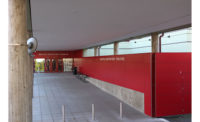When it comes to access control products and systems, whether the end user is a small 5- to 10-door business or a multi-city enterprise, chances are they ultimately will use only a small fraction of the feature-rich products that are available to them. It is far more important for the system to fit seamlessly into the larger business and its goals.
“I don’t think the features have changed a lot in the past three to five years,” says John Fenske, vice president of product marketing at HID Global, Irvine, Calif. “End user interest now is really at the architecture level. ‘How does the system adapt as my systems change? What is the interoperability and adaptability?’”
Connectivity, scalability, convenience, mobility and cost of ownership are the new buzzwords that sell. End users want an access control system that will take them through the next several years and provide them with information to ultimately help them do their jobs more efficiently and cost effectively.
“Traditional security sales relied heavily on the features and benefits of the access control system,” says integrator Todd Jackson, access control division manager for the Jackson, Miss., branch of Tull Brothers Inc. “While system features are still important to the user within our customer’s organizations, we are finding more often than not that the user is no longer the buyer. Today, our sales efforts typically span the breadth and all levels of our customer’s organization. Positively affecting the organization’s bottom line and creating business efficiencies through back-office application integration and improved processes take precedence. Bringing recognizable and quantifiable business value to an organization, while properly addressing its security concerns, has proven to be a successful formula in our sales efforts.”
While the “macro” features may sell the system, it is the day-to-day experience that will keep the customer happy. Being able to show both the big picture and the individual features tailored to the users’ needs and interests can really get their attention.
Whole Business Features
“Our end users look broadly at access control as a whole host of interconnected systems,” Fenske describes. “If they choose to change a controller or reader to leverage some new concept or feature, they want it not to break their whole architecture. There is a lot of discussion with end users looking at the system overall rather than specific features and functions. The release of open supervised device protocol (OSDP) is starting to ring true with end users.”
Standards or open systems ultimately allow the user to increase the convenience and productivity of their system by having it communicate with third-party systems and databases.
“Big users typically have more than one manufacturer installed in their facilities,” says Christopher Sincock, vice president, security business, DAQ Electronics LLC, Piscataway, N.J. How can they get everything to communicate and work together without having to start from scratch? Standards are the answer to that.”
The industry as a whole is listening, says Frank Gasztonyi, chief technology officer, Mercury Security, Long Beach, Calif. “I am seeing many industry players who are all collaborating to develop these standards because we see that this will be good for the industry as a whole. We know that in the next few years the ability to connect devices with these standards will be a requirement.”
End users do not want to be locked into one proprietary technology, particularly when they are making an investment as big as an access control system, believes Jeremy Earles, product marketing manager, readers and credentials, Allegion, Carmel, Ind. “If they make the wrong decision here, it could limit their options for many years to come.”
A huge change from just a few years ago is that it is no longer just the big customer interested in issues such as standards, integration and connectivity.
“A pretty common theme is connectivity,” says John Smith, senior channel marketing manager, Honeywell Security, Melville, N.Y. “They are taking what they have existing in their facility, whether that is access/video/intrusion or heating/lighting/payroll, and connecting the different pieces. At the enterprise level that is almost a minimum compete now. But even on the entry level users are starting to ask ‘can we make these systems talk?’ They are looking for enterprise-level features. The ability to do more with what they have has really come to the forefront over the last year.”
Smaller end users want the big features, too, though not at a big price, adds Jason Ouellette, product line director–access control, Tyco Security Products, Westford, Mass. “Certainly when you get into the smaller space, cost is always a factor. But now, for the price, they do want as much as possible in that box. And that seems to lead to a lot of key discussions. The push for enterprise sets are growing as companies are trying to make decisions based on future-proofing.”
Connectivity is extending all the way from enterprise applications down to home users.
“We have done a lot of research on consumers,” says Keith Brandon, director of sales and marketing for residential access solutions, Kwikset Corp., Lake Forest, Calif., which offers a Bluetooth-enabled lockset and a Home Connect product that controls other elements such as lighting and HVAC. “Consumers want to know how they can better interact with the lock and what more it can do for them.”
The same principle holds true in the commercial space, large and small.
“We offer a Data Exchange utility, which allows clients to integrate or tie to multiple databases,” says David Barnard, director of dealer development, RS2 Technologies LLC, Munster, Ind. “That offering has really grown in popularity because it takes something that used to take a programmer to do and now allows a technician or employee who understands databases to make those links and bring that data across. A couple of years ago when it was introduced, it was the truly large customers with 40,000 employees purchasing it. Now we are seeing it used by businesses that have 50 to 250 employees. Those productivity tools are starting to become much more important to mid-sized and small businesses, too.”
This makes sense, given some of the other trends in security, says integrator Dave Porter, general manager, AlphaCorp, Salt Lake City, Utah. “I think what is driving this is that more IT-savvy people are starting to make decisions as to what gets implemented at their sites. Now we see that trend even in small- to medium-sized companies. They have an inherent desire and understanding that things are simpler when you can manage them under one interface.”
Jackson agrees. “Today’s security purchases are significantly different than a few years ago. For nearly 10 years the security industry has discussed the convergence of physical security and IT as a futuristic event that was beginning to take shape. We believe that for all practical purposes we are in a post-convergent industry now.”
Big Feature Trends
While individual features may not be the main selling point these days, there are some trends that have emerged or continued across the industry that — depending on the customer — can make or break a sale.
“We have a handful of customers now that I would say mobility might be their most important feature set of the entire system,” Porter acknowledges. “The ability to lock and unlock a door through a handheld device is very important to them.”
Smith agrees. “A year ago we knew mobility was coming and now a lot of end users are looking for it. They don’t want software tied to a desktop. They want to be able to access the system anywhere, any time.”
DoorKing Inc., Inglewood, Calif., offers a service that allows the end user to do all the programming of the system via the Internet, says Richard Sedivy, director of marketing. “All they need is a connection and they can do everything they need and program the system or add and delete people. They like that for the simplicity,” he says.
“We have had a lot of inquiries about the use of tablets or iPhones or having mobile access,” adds integrator David Alessandrini, vice president, Pasek Corp., Boston. “Smaller clients are looking for access control where they don’t have software they have to manage. They want browser-based access that doesn’t require a client to be located on a computer.”
The typical consumer today uses cloud-based services every single day, says Mark Duato, senior director of integration solutions, ASSA ABLOY Door Security Solutions, New Haven, Conn. “I think the concept of outsourcing security as a service in some form has really taken on a lot of momentum in the past several years. It comes down to total cost of ownership. Instead of having to own all of this and manage it, why not leverage that as a service and let someone else manage the costs associated with maintaining a current solution?
“A lot of the technology that is getting the end users’ attention today is both for convenience and security. Most end users want to push more technology to the edge of the network and eliminate the traditional cost-heavy components and labor tied to installation and service. Integrated IP locks that are deployed either over a Wi-Fi network or communicate directly to the access control platform without the burden of expensive hardware between the edge and the host are a good example of this,” he describes.
To this same end, Power over Ethernet (PoE)-enabled devices have really emerged in the last year or so.
“PoE is just getting more popular and more requested,” says Dennis Geiszler, vice president of marketing, Keri Systems Inc., San Jose, Calif. “Part of that has to do with it getting more accepted and also more reliable and robust than it used to be.”
It has become so reliable that Axis recently came to market with an all-network-based system. “We built our system so you don’t necessarily need a server,” explains Ola Jonsson, business development manager responsible for access control initiatives, Axis Communications, Chelmsford, Mass. “All devices are PoE-based and sit at each and every door. Almost all new locks coming out now are usable on PoE.”
Jackson agrees. “PoE has been a very hot topic in the marketplace with customers since IT professionals are more commonly becoming responsible for physical security. PoE is something they understand and it makes them feel more in control.”
Daily Life ‘Small’ Features
End user buyers today may be all about the big stuff, but when it gets down to day-to-day workflow, the small things still matter.
“I think one of the things they are looking for is user ergonomics and a simple, intuitive interface,” says Christopher Sincock of DAQ Electronics LLC. We as manufacturers often load up our product with so many feature sets of which so few are used on a daily basis that the software can become unwieldy. At the end of the day, some poor individual has to sit down and monitor this and hope they can respond quickly and efficiently. The ability for customization of the workspace so that the individual only sees what they need to see is a small but crucial feature. A number of studies have shown that people can only process so much information for so long.”
Customization in general is a big “small” thing, adds Dennis Geiszler of Keri Systems Inc. “People want to do custom things on the fly, like when this group cards in, turn on these lights. These are functions that are done through input/output linking. Sometimes customers don’t know what they want. They get the system installed and then wish they could do something.”
“The term ‘possibilities’ really gets people excited,” says Dave Porter from AlphaCorp. “The possibility of doing more things in the future that they might not even be thinking of right now gets their attention.”
The other side of the coin from possibility is reliability. “There is a tendency to design a system where everything works 100 percent of the time, all of the time,” says Jim Pope, president, Barcode Automation Inc., Winter Springs, Fla. “Users want to know the reliability of the system. When an integrator can say ‘if this happens we can tie these two pieces together temporarily or use a cell network as a backup so you can still operate,’ that helps sell the system.”
What really impresses most people is the service behind the system, says integrator Richard Castle, president, Electronic Systems Int’l, Colorado Springs, Colo. “The security market has become so technical. You have to be certified in computers and software and multiple platforms. We offer service contracts to take care of all of their systems and we go in there once a week and check everything and keep the firmware up to date.”
One “small” feature that has gotten a lot of unfortunate attention in the past year is lockdown capability. Schools, in particular, want ways to lock classroom or building doors in response to active shooters. Other features of interest lately are Near Field Communications, Web apps, and email notifications.
Of course one of the most critical small features has always been reporting. “The ability to deploy custom reports or use ones that are part of the system is something people don’t always realize the importance of until they are using the system,” Porter explains. “Reporting tools vary greatly from system to system; once they use them they are either grateful — or not — for those tools.”
Tyco Security Products’ Jason Ouellette agrees. “Reporting packages are important. When people see the power of what they can harvest in terms of data, it starts to transcend barriers beyond access control. Being able to show that and other robust features beyond just opening doors can drive other opportunities.”
Finally, simplicity is the most important of all, says Scott Schramme, vice president of sales, Continental Access Control (a Napco Security Group Company), Amityville, N.Y. “It has to work. When you walk up and have to get in the door, ease of use is important. Once the integrator leaves and turns it over to the end user they don’t want to need a college degree to run the access control system.”
Dealer-friendly Features
End users are not the only ones looking for specific features. Dealers and integrators have their own preferences.
“Some of the things integrators are looking for are not so much the ‘latest and greatest,’” says Ron Gentner, Eastern group sales manager for EMS Division, ASSA ABLOY. “Whether it is locksmiths or integrators, the people actually doing the jobs would like to take a step back and make it easier to integrate everything. The more we change access control for the ‘good,’ the harder it is from their standpoint to actually meld it together.”
Christopher Sincock of DAQ Electronics LLC, agrees. “The more agnostic a solution is, the more desirable it is. The ability for systems to talk to multiple manufacturers of access control hardware is very desirable. Our panel uses BACnet as its native communications protocol, which resonates strongly with integrators and end users alike.” BACnet is a data communication protocol for building automation and control networks.
PoE is another feature that is just as attractive for integrators as it is for end users. “The easier the system is to install, the more choices the integrator has to provide power to a field device,” Sincock adds. Can it run on PoE or PoE Plus in addition to local power supplies? As security and access control becomes very network-centric, these are important considerations.”
The dealer has different needs than the end user, says John Smith of Honeywell Security. “Dealers are looking to get RMR on access control now, so big themes for them are lower installation costs through Web and cloud hosted solutions.”
More and more, integrators are looking for simplicity in installation, says John Fenske of HID Global. “To them that means IP architectures. They are not focused as much on the features but more on the simplicity and standardization of installation. They are very interested in standards so that from one access control product to the next they are not dealing with a completely different animal.”
Some manufacturers are working diligently to make installation as straightforward and quick as possible. For example, Axis Communications provides colored contacts for installation of its PoE-based access control product. “When you configure the device you get a color-coded scheme of where you should put in the cables,” describes Ola Jonsson of Axis Communications.
Mercury Security, too, offers an “Installer Assistant Utility,” which allows the installer to check out each panel with a laptop, tablet or smartphone to verify that the device is reading correctly. “Of all the features we have put forward in the past five years, this one has generated the most enthusiasm from the installation community,” says Frank Gasztonyi of Mercury Security. “Beyond that, what is most useful for them is the fact that the common hardware platform is used by multiple system vendors, which saves resources and employee training.”
While the access control industry is still in the emerging stage of creating true standards, this is probably the single most important feature that is going to matter to integrators and end users alike, Sincock believes. “At the end of the day, the manufacturers that provide the greatest amount of flexibility with the easiest-to-use-and-install product will be the ones end users and integrators will want to use.”














